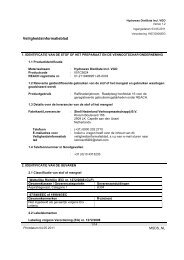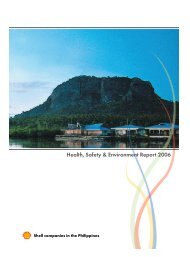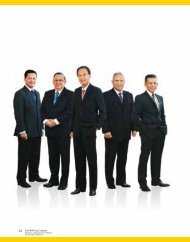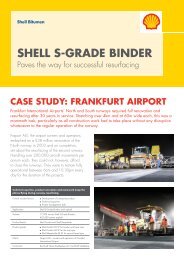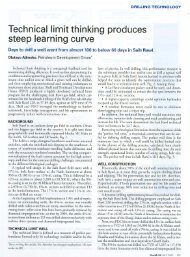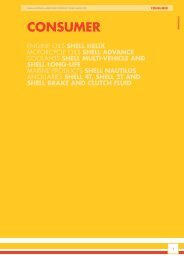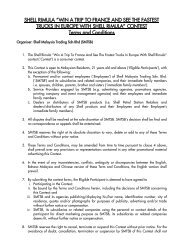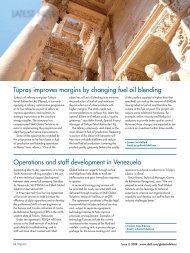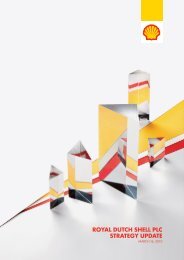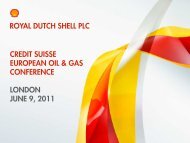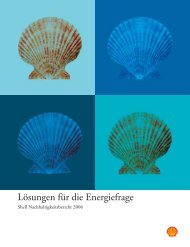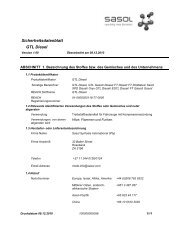Prelude Floating LNG Project Draft Environmental Impact ... - Shell
Prelude Floating LNG Project Draft Environmental Impact ... - Shell
Prelude Floating LNG Project Draft Environmental Impact ... - Shell
Create successful ePaper yourself
Turn your PDF publications into a flip-book with our unique Google optimized e-Paper software.
Executive Summary<br />
<strong>Prelude</strong> <strong>Floating</strong> <strong>LNG</strong> <strong>Project</strong><br />
<strong>Draft</strong> <strong>Environmental</strong> <strong>Impact</strong> Statement<br />
<strong>Shell</strong> Development (Australia) Proprietary Limited<br />
EPBC 2008/4146<br />
October 2009
Invitation to Comment<br />
<strong>Shell</strong> Development (Australia) Proprietary Limited (<strong>Shell</strong>)<br />
proposes to develop the <strong>Prelude</strong> petroleum reserves within<br />
Exploration Permit WA-371-P. The <strong>Prelude</strong> F<strong>LNG</strong> <strong>Project</strong><br />
is located in Commonwealth waters approximately 200<br />
kilometres offshore northwest Western Australia, in the<br />
northern Browse Basin.<br />
The <strong>Project</strong> will be carried out using a <strong>Floating</strong> Liquefied<br />
Natural Gas (F<strong>LNG</strong>) facility designed to extract and process<br />
natural gas and associated condensate, thereby avoiding the<br />
need for a “traditional” development comprising offshore<br />
platforms, export pipelines, an onshore liquefaction plant<br />
and export jetty. The <strong>Prelude</strong> F<strong>LNG</strong> <strong>Project</strong> is scheduled to<br />
commence production in 2016 with an estimated operational<br />
life of 25 years. Annual production is estimated to peak at<br />
3.6 million tonnes of <strong>LNG</strong>, 1.3 million tonnes of condensate<br />
and 0.4 million tonnes of Liquefied Petroleum Gas.<br />
The Commonwealth Minister for the Environment,<br />
Heritage and the Arts has determined that the <strong>Prelude</strong><br />
F<strong>LNG</strong> <strong>Project</strong> is a controlled action under the Environment<br />
Protection and Biodiversity Conservation Act 1999 (EPBC<br />
Act). It was determined that an <strong>Environmental</strong> <strong>Impact</strong><br />
Statement (EIS) would be required for the proposal. The<br />
controlling provisions under the EPBC Act are:<br />
• sections 18 and 18A (listed threatened species and<br />
communities);<br />
• sections 20 and 20A (listed migratory species); and<br />
• sections 23 and 24A (marine environment).<br />
<strong>Shell</strong> has prepared a draft EIS for the <strong>Prelude</strong> F<strong>LNG</strong> <strong>Project</strong><br />
in accordance with Part 8 of the EPBC Act. The draft EIS<br />
covers the drilling, installation, commissioning, operation,<br />
maintenance and decommissioning phases of the project.<br />
Viewing the <strong>Draft</strong> EIS<br />
Copies of the draft EIS will be held for viewing at the<br />
following locations:<br />
• Broome Public Library, Cnr Haas and Hamersley St,<br />
Broome<br />
• Derby Public Library, Clarendon St, Derby<br />
• The Department of Industry and Resources, 1st Floor,<br />
100 Plain St, East Perth<br />
• Battye Library, Alexander Library Building, 25 Francis St,<br />
Perth<br />
• Northern Territory Library, Bennett St, Darwin<br />
• DEWHA Library, John Gorton Building, King Edward<br />
Terrace, Parkes, Canberra<br />
Copies of the draft EIS are also available from <strong>Shell</strong>.<br />
Electronic copies of the draft EIS are available free of charge<br />
and may be downloaded from www.shell.com.au/prelude.<br />
Hard copies of the Executive Summary are available free of<br />
charge and hard copies of the full draft EIS are available for<br />
a charge of $20. Copies can be obtained by:<br />
• Telephoning: 1800 037 298<br />
• Emailing: SDA-<strong>Prelude</strong>drafteis@shell.com<br />
• Writing to: <strong>Prelude</strong> <strong>Draft</strong> EIS, <strong>Shell</strong> Development<br />
(Australia) Pty Ltd, 250 St Georges Terrace, Perth WA<br />
6000<br />
Submissions<br />
Interested persons or organisations may make a written<br />
submission in relation to the draft EIS. Submissions may<br />
be in relation to general issues covered by the draft EIS<br />
or on specific elements of the <strong>Prelude</strong> F<strong>LNG</strong> <strong>Project</strong>. All<br />
submissions received by <strong>Shell</strong> will be acknowledged, and<br />
copies forwarded to DEWHA.<br />
Submissions should:<br />
• specify which chapter or section each point relates to;<br />
• include factual and supporting information, including<br />
the source;<br />
• specify whether you wish for your submission to remain<br />
confidential;<br />
• provide personal details, including name and address,<br />
and identify any special interest that you have in the<br />
<strong>Prelude</strong> F<strong>LNG</strong> <strong>Project</strong>.<br />
Unless the submission specifies that it is to be confidential,<br />
all submissions will be treated as public documents.<br />
Submissions may be referred to or quoted in the final EIS.<br />
Submissions should be sent by e-mail or post to the above<br />
address.The draft EIS is available for public comment for<br />
a period of 30 business days and submissions close on<br />
FRIDAY 20th NOVEMBER 2009.
<strong>Prelude</strong> F<strong>LNG</strong> <strong>Project</strong>
FoREWoRD<br />
Thank you for taking the time to review the <strong>Draft</strong> <strong>Environmental</strong> <strong>Impact</strong> Statement for the<br />
<strong>Prelude</strong> <strong>Floating</strong> Liquefied Natural Gas (F<strong>LNG</strong>) <strong>Project</strong>.<br />
This <strong>Project</strong> involves the extraction, liquefaction and sale of natural gas and condensate from<br />
the <strong>Prelude</strong> field located off the north west coast of Australia, some 475 km north-north east<br />
of Broome. As Operator and 100% equity holder of the WA-371-P exploration permit, <strong>Shell</strong><br />
intends to develop the field in a timely, economic and environmentally sustainable manner.<br />
The <strong>Prelude</strong> F<strong>LNG</strong> <strong>Project</strong> will be the first application of <strong>Shell</strong>’s innovative F<strong>LNG</strong><br />
technology as a means to develop a relatively small and remote gas field which would<br />
otherwise be uneconomic to develop. By locating the processing and liquefaction<br />
facilities directly over the gas field, there is no need for an offshore platform, a pipeline to shore, jetty and dredging<br />
for shipping or onshore construction. This not only reduces cost, but also reduces the environmental footprint of<br />
the project.<br />
This <strong>Project</strong> is an example of how <strong>Shell</strong> is responding globally to what we call the “3 Hard Truths”.<br />
1. Increasing energy demand – the world continues to need more energy due to population growth and increasing<br />
standard of living in developing countries. <strong>LNG</strong> from <strong>Prelude</strong> will be exported to Asia providing cleaner energy to<br />
some of the highest growth rate countries in energy demand.<br />
2. No easy oil – oil and gas is a finite resource and becoming increasingly difficult to find and develop, with new<br />
discoveries in deeper waters further offshore and often as smaller, separate finds. For <strong>Prelude</strong>, the F<strong>LNG</strong> solution<br />
enables access to an otherwise stranded gas resource.<br />
3. Carbon constrained world – finding, developing and supplying energy needs to be done at a low carbon intensity<br />
to avoid worsening the impacts of climate change on our planet. <strong>LNG</strong> is an energy source that emits far less CO 2<br />
for power generation than coal or fuel oil over the extraction to combustion lifespan.<br />
The <strong>Prelude</strong> F<strong>LNG</strong> <strong>Project</strong> is a very exciting project for <strong>Shell</strong> in Australia:<br />
• It is fast! The <strong>Prelude</strong> gas discovery was made in January 2007 and the project is expected to begin production in<br />
2016, making it a fasttrack <strong>LNG</strong> development;<br />
• It will be <strong>Shell</strong>’s first application of F<strong>LNG</strong> technology, a solution which has the potential to unlock much of<br />
Australia’s, and the world’s, stranded gas assets;<br />
• It has a low environmental footprint which is restricted to its location 200 km offshore, away from sensitive<br />
environmental receptors such as turtles, whales and the Kimberley coastline; and<br />
• It will deliver economic benefits to the region and Australia through 25 years of operation, producing a valuable<br />
export commodity and employing Australians to operate and maintain the F<strong>LNG</strong> facility.<br />
I encourage you to review this draft EIS and provide feedback on <strong>Shell</strong>’s proposed <strong>Prelude</strong> F<strong>LNG</strong> <strong>Project</strong>. We look<br />
forward to hearing from you.<br />
Jon Chadwick<br />
<strong>Shell</strong>’s Executive Vice President, Upstream International - Australia
<strong>Prelude</strong> F<strong>LNG</strong> <strong>Project</strong>
EXECUTIVE SUMMARY<br />
INTRoDUCTIoN<br />
The Australian Commonwealth Government awarded<br />
<strong>Shell</strong> Development (Australia) Proprietary Limited (<strong>Shell</strong>)<br />
Exploration Permit WA-371-P in January 2006, as a 100%<br />
equity holder. The title area is located in the Northern Browse<br />
Basin, a hydrocarbon province with major undeveloped<br />
gas fields. In November 2006, <strong>Shell</strong> commenced drilling<br />
activities and in January 2007 discovered the <strong>Prelude</strong> field.<br />
Figure ES.1 Location of <strong>Prelude</strong> F<strong>LNG</strong> <strong>Project</strong><br />
(Exploration Permit Area WA-371-P)<br />
<strong>Shell</strong> proposes to develop the <strong>Prelude</strong> field using a <strong>Floating</strong><br />
Liquefied Natural Gas (F<strong>LNG</strong>) Facility which will produce,<br />
liquefy and export the gas resource in line with the Australian<br />
Offshore Petroleum Development policy. This project is<br />
named the ‘<strong>Prelude</strong> F<strong>LNG</strong> <strong>Project</strong>’. The proposed <strong>Prelude</strong><br />
F<strong>LNG</strong> <strong>Project</strong> is located approximately 200 km offshore<br />
northwest Australia and 475 km north-northeast of Broome<br />
(see Figure ES.1).<br />
The purpose of the draft <strong>Environmental</strong> <strong>Impact</strong> Statement<br />
(EIS) is to provide the regulator the information required<br />
to assess the proposal against the requirements of the<br />
Environment Protection and Biodiversity Conservation Act<br />
1999 (EPBC Act), to inform the general public about the<br />
proposal, and to demonstrate that the potential negative<br />
impacts of the proposed project are addressed and potential<br />
positive benefits maximised. The draft EIS:<br />
• presents details of the <strong>Prelude</strong> F<strong>LNG</strong> <strong>Project</strong> concept;<br />
• describesthephysical,biologicalandhumancomponents<br />
of the environment where the <strong>Project</strong> will be located.<br />
This includes technical studies (including modelling<br />
where appropriate), literary reviews, collection of<br />
primary data and stakeholder consultation;<br />
• identifies and assesses potential environmental or socioeconomic<br />
impacts associated with the proposed <strong>Project</strong><br />
using accepted <strong>Impact</strong> Assessment methodologies;<br />
• defines mitigation and management measures to<br />
minimise any potential adverse impacts; and<br />
• demonstrates compliance with the EPBC Act.<br />
1
SHELL DEVELOPMENT (AUSTRALIA)<br />
Th e project proponent and title holder of Exploration<br />
Permit WA-371-P is <strong>Shell</strong> Development (Australia)<br />
Proprietary Limited (<strong>Shell</strong>), a subsidiary of Royal Dutch<br />
<strong>Shell</strong> plc 1 which is a major global energy organisation<br />
employing around 3,000 people in Australia. Th e Australian<br />
organisation is divided broadly into ‘upstream’ and<br />
‘downstream’ businesses. Th e upstream business is based in<br />
Perth, Western Australia and fi nds, develops and supplies<br />
Liquefi ed Natural Gas (<strong>LNG</strong>), condensates and Liquefi ed<br />
Petroleum Gas (LPG) to overseas markets, and natural gas<br />
to domestic customers.<br />
<strong>Shell</strong> is committed to sustainable development and to<br />
produce energy responsibly. Th is means helping meet the<br />
world’s growing need for energy in economically, socially<br />
and environmentally responsible ways.<br />
<strong>Shell</strong> has a comprehensive set of policies, standards and<br />
procedures for managing its projects and operations with<br />
consideration of environmental matters. <strong>Shell</strong>’s policy and<br />
commitment to Health, Safety and Environment (HSE)<br />
includes a commitment to ‘pursue the goal of no harm to<br />
people’ and to ‘protect the environment’. <strong>Shell</strong>’s activities in<br />
Australia are managed in line with the <strong>Shell</strong> Group global<br />
HSE policies, standards and procedures.<br />
<strong>Shell</strong>’s approach to Responsible Energy can be found at:<br />
http://www.shell.com<br />
<strong>Shell</strong>’s commitments and standards are available at:<br />
http://www.shell.com/home/content/responsible_energy/<br />
integrated_approach/our_commitments_and_standards/<br />
dir_commitments_standards.html<br />
2 <strong>Prelude</strong> F<strong>LNG</strong> <strong>Project</strong><br />
Th e most recent <strong>Shell</strong> Group Sustainability Report<br />
is available at: http://www.shell.com/home/content/<br />
responsible_energy/sustainability_reports/dir_shell_<br />
sustainability_reports.html<br />
<strong>Shell</strong>’s HSE philosophy in Australia can be found at: http://<br />
www.shell.com/home/content/au-en/about_shell/2008/<br />
environment_and_society/people_and_enviro.html?LN=/<br />
leftnavs/zzz_lhn2_4_2.html<br />
LEGAL REQUIREMENTS & STANDARDS<br />
Th e <strong>Prelude</strong> F<strong>LNG</strong> <strong>Project</strong> will be located in Australian<br />
Commonwealth waters. Th e primary environmental<br />
legislation relating to its approval is the Commonwealth<br />
EPBC Act and the accompanying EPBC Regulations, 2000.<br />
Th e EPBC Act is administered by the Commonwealth<br />
Minister for the Environment, Heritage and the Arts. Th is<br />
draft EIS has been prepared in accordance with Guidelines<br />
issued for the <strong>Project</strong> by DEWHA and in accordance<br />
with the provisions of the EPBC Act. Th ese requirements,<br />
together with other relevant Australian and international<br />
guidance and regulations, and <strong>Shell</strong>’s own Policies, Standards<br />
and Guidelines, have been taken into consideration in the<br />
<strong>Prelude</strong> F<strong>LNG</strong> <strong>Project</strong> design and draft EIS.<br />
Compliance with relevant environmental and social<br />
performance standards and draft EIS commitments will<br />
be implemented through the <strong>Prelude</strong> Health Safety and<br />
Environment Management System (HSE-MS). Safety<br />
requirements are addressed separately in accordance with<br />
National Off shore Petroleum Safety Authority (NOPSA)<br />
requirements 2 .<br />
1 Royal Dutch <strong>Shell</strong> plc and the companies in which it directly or indirectly owns investments are separate and distinct entities. In this publication, the collective expressions<br />
‘<strong>Shell</strong>’ and ‘<strong>Shell</strong> Group’ may be used for convenience where reference is made in general to those companies. Likewise, the words ‘we’, ‘us’, ‘our’, and ‘ourselves’ are used in<br />
some places to refer to the companies of the <strong>Shell</strong> Group in general. Th ese expressions are also used where no useful purpose is served by identifying any particular company or<br />
companies.<br />
2<br />
NOPSA is a Statutory Agency regulating Commonwealth, State and Territory coastal waters with accountability to the relevant Ministers. Th e role of NOPSA is to<br />
administer off shore petroleum safety legislation.
PRELUDE F<strong>LNG</strong> PRoJECT<br />
Overview<br />
The objective of the <strong>Prelude</strong> F<strong>LNG</strong> <strong>Project</strong> is to produce,<br />
liquefy and export the gas resources of the <strong>Prelude</strong> field to<br />
help meet growing global energy demands.<br />
<strong>Project</strong> Concept and Design<br />
The F<strong>LNG</strong> concept provides a technically innovative<br />
solution for the development of the small and remote<br />
<strong>Prelude</strong> field in a cost-effective and environmentally and<br />
socially sound manner. By floating the <strong>LNG</strong> facility, the<br />
<strong>Prelude</strong> F<strong>LNG</strong> <strong>Project</strong> avoids the need for a “traditional”<br />
onshore development scenario that would ordinarily<br />
comprise offshore platform(s), export pipeline(s), an<br />
onshore liquefaction plant, export jetty and the associated<br />
facility preparation works including coastal dredging. The<br />
<strong>Prelude</strong> F<strong>LNG</strong> <strong>Project</strong> will comprise:<br />
• A steel, double-hulled floating facility, approximately<br />
480 m in length by 70-80 m wide. on this substructure<br />
the gas receiving, processing (treating, separation and<br />
liquefaction), storage and offloading equipment will<br />
be mounted. The facility also contains other associated<br />
components such as the control room, maintenance<br />
areas and accommodation. It will be designed to<br />
produce 3.6 million tonnes per annum (mtpa) of <strong>LNG</strong>,<br />
plus LPG and condensate for export.<br />
• Upstream facilities including subsea production wells<br />
and manifolds; subsea flowlines; riser base manifolds;<br />
flexible risers that transport the gas, condensate and<br />
any produced formation water to the F<strong>LNG</strong> facility;<br />
and, umbilicals used to control the wells and associated<br />
facilities.<br />
The proposed <strong>Prelude</strong> F<strong>LNG</strong> facility will be the first of its<br />
kind to be deployed in Australia. In concept, the F<strong>LNG</strong><br />
facility will be similar to existing <strong>Floating</strong> Production,<br />
Storage and Offloading (FPSO) facilities used for production<br />
of hydrocarbons. The main design elements of the F<strong>LNG</strong><br />
facility are:<br />
• Gas will reach the facility from seafloor wellheads via<br />
flowlines for processing on the facility topsides where<br />
the gas is treated to remove acid gases such as carbon<br />
dioxide and hydrogen sulphide, impurities, and water.<br />
• A refrigeration plant will then cool the gas to separate<br />
out heavier hydrocarbons, which form condensate and<br />
LPG. Cooling continues until the natural gas reaches a<br />
temperature of minus 162°C, at which point it becomes<br />
a liquid and is transferred to insulated tanks within<br />
the F<strong>LNG</strong> facility to be stored at near atmospheric<br />
pressure.<br />
• Cooling requirements for processing of the gas will<br />
require approximately 50,000 m 3 /hr of seawater which<br />
will be taken from a depth of around 150 m below sea<br />
level.<br />
• Power requirements will be met by steam boilers. The<br />
steam will drive compressors and electrical generators<br />
and also provide process heat requirements.<br />
• <strong>LNG</strong> and LPG tankers will moor alongside the F<strong>LNG</strong><br />
facility. Hard loading arms with swivel joints and quick<br />
connect/disconnect flanges will be used for transferring<br />
the <strong>LNG</strong> and LPG products to the tankers. Condensate<br />
tankers will be moored astern of the F<strong>LNG</strong> facility and<br />
condensate transferred by a floating hose as per standard<br />
industry practice for FPSOs.<br />
• The F<strong>LNG</strong> facility will not disconnect during bad<br />
weather and is designed to withstand severe weather<br />
including a 1 in 10,000 year weather event. The facility<br />
will be held in position by four groups of six anchor<br />
chains, arranged around the F<strong>LNG</strong> turret. The chains<br />
are secured by suction piles which penetrate deep into<br />
the seabed.<br />
Figure ES.2 provides an indicative illustration of the proposed<br />
F<strong>LNG</strong> facility and associated infield infrastructure.<br />
<strong>Prelude</strong> F<strong>LNG</strong> <strong>Project</strong> Schedule<br />
Front-End Engineering and Design (FEED) for the project<br />
is expected to begin in the second half of 2009 with the<br />
Financial Investment Decision (FID) scheduled for early<br />
in 2011. From the FID it will take approximately five years<br />
for the F<strong>LNG</strong> facility to be constructed and then towed<br />
to location. Whilst the facility is being built, the subsea<br />
production wells will be drilled and the infrastructure<br />
installed in time to supply gas to the F<strong>LNG</strong> facility on its<br />
arrival at the field.<br />
3
Figure ES.2 Illustration of the Proposed F<strong>LNG</strong> Facility and Associated Infield Infrastructure<br />
<strong>LNG</strong> Carrier<br />
4 <strong>Prelude</strong> F<strong>LNG</strong> <strong>Project</strong><br />
F<strong>LNG</strong> Facility<br />
The development drilling program is expected to take<br />
approximately two years, commencing in 2013. An<br />
indicative timeline for the project is provided in Table<br />
ES.1.<br />
Table ES.1 Indicative <strong>Project</strong> Timeline<br />
<strong>Project</strong> Phase Target Date<br />
Development drilling 2013<br />
Subsea construction 2014<br />
F<strong>LNG</strong> facility construction and delivery to field 2015<br />
Commissioning 2015<br />
First gas 2016<br />
Decommissioning 2040<br />
<strong>Prelude</strong> F<strong>LNG</strong> <strong>Project</strong> Stages<br />
The key elements of the <strong>Prelude</strong> F<strong>LNG</strong> <strong>Project</strong> included<br />
in the draft EIS are:<br />
• development well drilling;<br />
• subsea structure installation;<br />
Flowlines<br />
Wellheads<br />
Anchors<br />
• tow-out and hook up of the F<strong>LNG</strong> facility;<br />
• commissioning;<br />
• operations; and<br />
• decommissioning.<br />
Onshore support facilities required during construction,<br />
commissioning and operation will be located in the<br />
existing ports of either Broome or Darwin and established<br />
in existing industrial areas. The operation of these onshore<br />
facilities will be subject to consideration under the Western<br />
Australian State or NorthernTerritory government planning<br />
and approvals processes (as applicable) and are outside the<br />
scope of the draft EIS.<br />
The F<strong>LNG</strong> facility will be constructed and commissioned at<br />
a Korean Shipyard. The overseas construction of the F<strong>LNG</strong><br />
facility is outside the scope of the draft EIS.
<strong>Prelude</strong> Activities and <strong>Environmental</strong> Aspects<br />
A summary of key infield installation, commissioning,<br />
operation, maintenance and decommissioning activities<br />
<strong>Prelude</strong> F<strong>LNG</strong> <strong>Project</strong> - Key Activities<br />
Infield Installation Activities<br />
Activity Key Details <strong>Environmental</strong> Aspects<br />
Development Drilling • Mobile offshore Drilling Unit drills 8 production<br />
wells over 2 year period<br />
• Water and synthetic based muds<br />
• Flaring for 1 to 2 days per well during completion<br />
Installation of Subsea<br />
Facilities<br />
F<strong>LNG</strong> Hook Up<br />
Vessel Activities (including<br />
towing F<strong>LNG</strong> facility<br />
to site)<br />
• 8 wells tied back to the manifolds and connected<br />
to F<strong>LNG</strong> facility via 4 x 4 km flowlines<br />
• Footprint size of 4 anchor grouping is approx.<br />
150 m2 • Risers and umbilicals connect subsea facilities to<br />
F<strong>LNG</strong> facility. Duration of F<strong>LNG</strong> installation<br />
and hook up approximately 6 months<br />
• 500 m exclusion safety zone extending from<br />
the outer edge of the F<strong>LNG</strong> facility and subsea<br />
infrastructure<br />
• Tugs, pipe lay /crane vessel<br />
• Remotely operated Vechicles with support vessel<br />
• Riser and umbilical installation vessels<br />
are described in Table ES.2. For each of these activities the<br />
key environmental aspects are described. These have been<br />
addressed in detail in the draft EIS.<br />
Table ES.2 Summary of Key Activities and Associated <strong>Environmental</strong> Aspects for the <strong>Prelude</strong> F<strong>LNG</strong> <strong>Project</strong><br />
• Drill cuttings (approximately 1,000 m3 per well) disposed<br />
overboard<br />
• Water based drill mud disposal to sea upon completion of<br />
well drilling program. Synthetic based mud as coating on<br />
drill cuttings (approximately 36 m3 per well)<br />
• Atmospheric emissions from flare<br />
• Noise emissions<br />
• Light emissions<br />
• Disturbance of seabed<br />
• Physical disturbance of seabed (approximately<br />
8,000 m2 )<br />
• Energy usage – fuel<br />
• Atmospheric emissions<br />
• Noise and light emissions<br />
• Discharge of ballast and bilge water<br />
Activity Key Details<br />
Commissioning Activities<br />
<strong>Environmental</strong> Aspects<br />
Logistical support • Supply vessels (weekly)<br />
• Atmospheric emissions<br />
• Helicopter flights (average 2 return per day) • Physical presence of vessels and helicopters<br />
• Ballast water<br />
• Bilge water and drainage water<br />
• Noise and light emissions<br />
Hydrotesting and dewatering<br />
of flowlines and<br />
F<strong>LNG</strong> facility pipe work<br />
• Seawater, corrosion inhibitor, biocide and MEG • Hydrotest water discharge<br />
Activity Key Details<br />
Operation and Maintenance Activities<br />
<strong>Environmental</strong> Aspects<br />
Logistical support • 1 supply vessel call per 1 to 2 weeks<br />
• Noise and light emissions<br />
• 1 vessel on standby at F<strong>LNG</strong> facility and 1 in port • Ballast water<br />
• 6 return helicopter flights per week<br />
• 500 m exclusion zone<br />
• Atmospheric emissions<br />
5
Table ES.2 Summary of Key Activities and Associated <strong>Environmental</strong> Aspects for the <strong>Prelude</strong> F<strong>LNG</strong> <strong>Project</strong> (Continued)<br />
6 <strong>Prelude</strong> F<strong>LNG</strong> <strong>Project</strong><br />
<strong>Prelude</strong> F<strong>LNG</strong> <strong>Project</strong> - Key Activities<br />
Operation and Maintenance Activities<br />
Activity Key Details <strong>Environmental</strong> Aspects<br />
Well, infield flowline and<br />
flexible riser operations<br />
F<strong>LNG</strong> facility operations<br />
• Subsea control fluid – water based<br />
• Life of field – 25 years<br />
• Design capacity of 3.6 mtpa <strong>LNG</strong>, 0.4 mtpa LPG<br />
and 1.3 mtpa condensate<br />
Export shipping • <strong>LNG</strong> carriers weekly<br />
• LPG tankers monthly<br />
• Condensate tankers once per fortnight<br />
• 2 Standby tugs<br />
Maintenance activities • Maintenance of wells and the F<strong>LNG</strong> facility on<br />
an estimated 4 year cycle<br />
• Estimated discharge volume of Subsea control fluid is 23<br />
m3 per year<br />
• Noise emissions<br />
• Light emissions<br />
• Produced formation water and drainage water discharge<br />
• Cooling water discharge (7.5˚C to 16˚C above<br />
ambient seawater temperature with residual chlorine<br />
concentration – 0.2 ppm)<br />
• Estimated atmospheric emissions – Co2 – 2,300,000 tpa,<br />
H2S – 171 tpa, Nox – 2,278 tpa, VoC – 1,799 tpa<br />
• Waste – hazardous and non hazardous solid wastes returned<br />
to shore<br />
• Sewage/grey water<br />
• Ballast water discharge<br />
• Accidental spillages<br />
• Noise and light emissions<br />
• Noise emissions<br />
• Light emissions<br />
• Atmospheric emissions<br />
Activity Key Details<br />
Decommissioning Activities<br />
<strong>Environmental</strong> Aspects<br />
Flushing of subsea • Flush flowlines until oil-in-water below 30 mg/l • Treated on F<strong>LNG</strong> Facility prior to discharge<br />
flowlines<br />
• Wells will be plugged with cement<br />
• Physical presence<br />
Capping of wells • Flowlines and manifolds removed if required • Air emissions<br />
Removal and towing of<br />
F<strong>LNG</strong> facility<br />
• Tugs and Supply vessels<br />
• Noise and light emissions<br />
Alternatives Considered<br />
<strong>Shell</strong> examined a range of alternatives to develop the <strong>Prelude</strong><br />
field including ‘do nothing’, a traditional onshore <strong>LNG</strong><br />
plant at a number of proposed locations and the technically<br />
innovative offshore F<strong>LNG</strong> solution. The preferred outcome<br />
of the assessment was F<strong>LNG</strong> as it offered:<br />
• the lowest environmental footprint;<br />
• a lower development cost; and<br />
• flexibility to subsequently relocate the F<strong>LNG</strong> facility to<br />
other fields.<br />
The application of F<strong>LNG</strong> technology for the <strong>Prelude</strong> F<strong>LNG</strong><br />
<strong>Project</strong> could provide the catalyst for the development<br />
of other small, remote gas fields (often referred to as<br />
stranded gas assets) that are otherwise difficult to develop<br />
commercially with conventional solutions.<br />
Possible Future Expansion or Modification<br />
The F<strong>LNG</strong> facility is designed to operate in the field for<br />
25 years with the <strong>Prelude</strong> production period dependent<br />
upon the actual volume of reservoir gas. When the pressure<br />
reduces in the <strong>Prelude</strong> field as gas is produced, the decline<br />
in production rate may be backfilled by tiebacks from<br />
other gas sources in the region in order that the F<strong>LNG</strong><br />
facility continuously operates efficiently at full throughput.<br />
Exploration is still underway but likely backfill gas sources<br />
are the nearby Concerto field, the Crux field and the Libra<br />
field. Such tiebacks would be the subject of a separate<br />
environmental approvals process to cover their field<br />
development.
CoNSULTATIoN<br />
Consultation for the <strong>Prelude</strong> F<strong>LNG</strong> <strong>Project</strong> has been<br />
conducted to meet the Commonwealth’s expectations<br />
for an EIS level assessment and is in accordance with<br />
<strong>Shell</strong>’s requirements. Key stakeholders included in the<br />
consultation process to date are government, Non-<br />
Government Organisations, businesses, residents, industry<br />
and indigenous groups. Key stakeholder interests include<br />
but are not limited to:<br />
1) <strong>Project</strong> economics.<br />
2) Health, safety and the environment.<br />
3) Greenhouse gas emissions.<br />
4) Employment and business opportunities.<br />
Stakeholder engagement and consultation is an integral<br />
part of <strong>Shell</strong>’s project development process, helping to<br />
inform business decisions and identify issues that require<br />
action. <strong>Shell</strong> has internal policies and processes that<br />
outline the requirements of stakeholder engagement. These<br />
are underpinned by the <strong>Shell</strong> Group’s General Business<br />
Principles that govern how <strong>Shell</strong> conduct its affairs.<br />
Stakeholder engagement is a key element of a project<br />
<strong>Impact</strong> Assessment process. The <strong>Prelude</strong> F<strong>LNG</strong> <strong>Project</strong><br />
has adopted a systematic process starting with issues<br />
analysis, leading to stakeholder identification, development<br />
of a Stakeholder Engagement Plan and development of<br />
stakeholder relationships and partnerships through a variety<br />
of engagement methods.<br />
Stakeholders identified for the <strong>Prelude</strong> F<strong>LNG</strong> <strong>Project</strong><br />
comprise individuals and organisations including federal<br />
government, state and territory governments, nongovernment<br />
organisations (NGOs), local businesses and<br />
residents, industry representative organisations, indigenous<br />
representative groups and academia.<br />
Since 2007, <strong>Shell</strong> has conducted three main ‘waves’ of<br />
engagement, broadly held in line with the EIS process<br />
(after the discovery of the field, after submission of<br />
the <strong>Environmental</strong> Referral and prior to the draft EIS<br />
submission). In addition to these engagements there have<br />
been separate briefings with specific stakeholders, either as<br />
a one-off on a particular issue or as regular updates for those<br />
stakeholders with a high level of interest in the <strong>Project</strong>. For<br />
example, the NOPSA and the Australian Maritime Safety<br />
Authority (AMSA) have been regularly briefed on the<br />
design and operation of the F<strong>LNG</strong> facility.<br />
An overview of the issues raised by government and industry<br />
representatives includes:<br />
• tax revenues (onshore versus offshore);<br />
• project milestones and economics;<br />
• integration with other Browse Developments;<br />
• safety of the F<strong>LNG</strong> facility;<br />
• security of the F<strong>LNG</strong> facility;<br />
• domestic gas possibilities;<br />
• carbon dioxide management; and<br />
• <strong>Shell</strong>’s evaluation of onshore facility locations.<br />
Representatives of community organisations and NGos<br />
including the Kimberley Land Council, Kimberley<br />
Development Commission, Environs Kimberley, Save The<br />
Kimberley, Shire of Broome and World Wildlife Fund had<br />
questions similar to those raised by government but also<br />
have interests relating to:<br />
• onshore facilities, workforce opportunities (including<br />
fly-in fly-out) and accommodation requirements in<br />
Broome;<br />
• potential environmental impacts eg cooling water<br />
management, carbon dioxide emissions, waste<br />
management;<br />
• indigenous opportunities eg employment;<br />
• safety, with regard to increased vehicle and air<br />
movements, and emergency response procedures;<br />
• opportunities for local businesses; and<br />
• issues associated with exploration activities eg number<br />
of drilling wells and location of activities offshore.<br />
Future Engagement<br />
Stakeholder engagement will continue to help inform and<br />
guide development planning for the <strong>Prelude</strong> F<strong>LNG</strong> <strong>Project</strong>.<br />
This will include systematic engagement on the relevant<br />
aspects of:<br />
• the environmental impact of the proposed <strong>Prelude</strong><br />
F<strong>LNG</strong> <strong>Project</strong>;<br />
• the decision on the location of the onshore Maintenance<br />
Workshop;<br />
• the hydrocarbon recovery and Field Development<br />
Plan;<br />
7
• the decision for the project to enter the FEED phase;<br />
• identifying possible partnerships and opportunities for<br />
<strong>Shell</strong>’s Social Performance Plan for the <strong>Prelude</strong> F<strong>LNG</strong><br />
<strong>Project</strong>;<br />
• safety and security of the F<strong>LNG</strong> facility; and<br />
• maximising the amount of employment opportunities<br />
the <strong>Project</strong> will generate for Australia eg through the<br />
development of an Australian Industry Participation<br />
Plan.<br />
ENVIRoNMENTAL & SoCIAL CoNTEXT<br />
The draft EIS describes the environmental and social context<br />
(or baseline) of the <strong>Prelude</strong> F<strong>LNG</strong> <strong>Project</strong> including physical<br />
environment, local and regional ecosystems, communities<br />
and habitats, key flora and fauna species and the social and<br />
cultural environment.<br />
Physical Marine Environment<br />
The physical marine environment of the project area is typical<br />
of the North West Shelf. Literature review and baseline<br />
assessment confirmed the following characteristics:<br />
1) A subtropical climate with a distinct monsoon season<br />
where cyclones generally occur between December and<br />
April. Sea wave heights during extreme cyclones are<br />
recorded up to 7 m.<br />
2) Sea surface temperatures range between 27°C and 30°C<br />
and in deeper waters (~150 m) are approximately 19°C.<br />
3) The sea floor comprises of fine clays, muds and sands.<br />
No reefs or areas of rocky substrate are known within the<br />
<strong>Project</strong> area.<br />
4) Offshore North West Shelf waters are typically low<br />
in nutrients. Low nitrate concentrations and low<br />
phytoplankton abundance were measured in the project<br />
area (July 2008).<br />
The <strong>Prelude</strong> F<strong>LNG</strong> <strong>Project</strong> is located in waters approximately<br />
250 m deep. There are no significant topographical features<br />
or changes to seabed bathymetry in the project area.<br />
Browse Island is the nearest feature of significance, located<br />
approximately 40 km south southeast of the project area.<br />
other islands/reefs in the region include Scott Reef and<br />
Sandy Islet (approximately 140 km southwest), Seringapatam<br />
Reef (approximately 80 km west) and Ashmore Reefs and<br />
Cartier Island (approximately 140 km north).<br />
8 <strong>Prelude</strong> F<strong>LNG</strong> <strong>Project</strong><br />
National and multinational oil companies have undertaken<br />
petroleum activities, including seismic surveys and<br />
exploratory drilling, in the Browse Basin for four decades.<br />
Ecosystems, Communities and Habitats<br />
Key ecosystem characteristics of the project area are:<br />
1) No reefs, seagrass or algal beds or islands occur within<br />
the project area.<br />
2) There are Humpback Whale migration routes and calving<br />
areas within the region, however these are a considerable<br />
distance away from the project area, nearer the coast.<br />
3) Pygmy Blue Whales are known to transit through the<br />
region but there are no known aggregation areas in or<br />
near the project area.<br />
4) The closest turtle breeding area to the project area is<br />
Browse Island, 40 km south southeast.<br />
5) There are bird migration routes within close proximity to<br />
the project area but no nesting sites.<br />
General regional and local characteristics related to<br />
ecosystem, communities and habitat are described in Table<br />
ES.3.<br />
Key Flora and Fauna Species<br />
Regionally, offshore north west Australia supports a variety<br />
of species including whales, dolphins, sharks and turtles.<br />
Vulnerable, endangered and migratory species listed under<br />
the EPBC Act that occur in the region include the Humpback<br />
Whale, Blue Whale, Green and Flatback turtles and several<br />
species of migratory birds. While some of these species are<br />
present in the region in significant numbers, none have<br />
any specific dependence on the project area. Low densities<br />
of migratory shorebirds and seabirds protected under the<br />
Japanese-Australia Migratory Bird Agreement (JAMBA),<br />
China-Australia Migratory Bird Agreement (CAMBA) and<br />
Republic of Korea-Australia Migratory Bird Agreement<br />
(RoKAMBA) bilateral agreements may also pass through<br />
the project area. A summary of key species is provided in<br />
Table ES.4.
Table ES.3 Characteristics Related to Ecosystems, Communities and Habitats<br />
Characteristics Description<br />
Sound Natural underwater sounds are produced by wind, waves, currents, rain, echo-location and communication<br />
noises generated by cetaceans. Fish choruses, vessel and seismic survey noises were also recorded during<br />
investigations.<br />
Plankton Phytoplankton were found to be highly diverse but low in abundance. Overall densities of crustacean assemblages<br />
were relatively low.<br />
Macrobenthos Macrobenthos (organisms which live within the seabed sediments) was found to be high in diversity of species<br />
but low in abundance.<br />
Corals Offshore atolls and fringing reefs around Browse Island support major assemblages of reef building corals but<br />
there are no known shallow coral reefs present within the WA-371-P title area.<br />
Seagrasses and Macroalgae The average depth of the project area precludes the occurrence of seagrasses and macroalgae.<br />
Existing and proposed Marine<br />
Protected Areas<br />
Key flora and fauna species See Table ES.4<br />
Socio-Economic and Cultural Environment<br />
There are no known areas of environmental significance in the immediate vicinity of the project area. No<br />
endangered or vulnerable species reside permanently in the project area, although some pass through on migratory<br />
routes. Browse Island, located 40 km away, is a Western Australian Class C Reserve (No. 22697) vested<br />
with the Conservation Commission under DEC control. The Island is a regionally important turtle and bird<br />
nesting site and is surrounded by coral reefs.<br />
The project area is located in open ocean and there are<br />
no known cultural or heritage issues associated with the<br />
<strong>Prelude</strong> F<strong>LNG</strong> <strong>Project</strong>.<br />
The project area may be traversed by mariners and fishermen<br />
but the area does not appear to overlap with any known sea<br />
lanes or active fishing grounds.<br />
The project area lies within the area that allows access rights<br />
for traditional Indonesian fishers to continue customary<br />
practices to harvest species such as trepang, trochus, abalone<br />
and sponges in Australian waters. These traditional fishers<br />
fish in shallow waters so they are only found in deepwater<br />
areas during transit to and from reef locations, so are<br />
unlikely to be affected by the <strong>Prelude</strong> F<strong>LNG</strong> <strong>Project</strong>.<br />
Tourism is significant along the coast of the Kimberley from<br />
Exmouth to Broome. Whilst charter fishing companies<br />
frequent the broader region there are no known tourist<br />
attractions or destinations within the project area.<br />
PoTENTIAL IMPACTS<br />
Overview<br />
Identifying impacts starts in the earliest phases of the project<br />
design and continues through the lifecycle of the project.<br />
The <strong>Impact</strong> Assessment methodology undertaken during<br />
the draft EIS provides a robust process for:<br />
• identification of potential impacts;<br />
• prediction of the significance of an impact;<br />
• development of mitigation and/or management<br />
measures; and<br />
• monitoring and reporting the effectiveness of the<br />
proposed mitigation measures.<br />
Key <strong>Impact</strong>s<br />
The EPBC Act defines a ‘significant impact’ as an impact<br />
which is important, notable or of consequence, having<br />
regard to its context or intensity. Whether or not an action<br />
is likely to have a significant impact depends upon the<br />
sensitivity, value and quality of the environment which is<br />
impacted, and upon the intensity, duration, magnitude and<br />
geographic extent of the impacts.<br />
9
Table ES.4 Key Species of Fauna<br />
Species Importance 3 Species Information<br />
Whales migrate seasonally through the waters of northwest Australia from Antarctic summer feeding grounds to winter calving<br />
grounds off the Kimberley coast. Calving grounds are south of the project area near the coast. Humpback whales have<br />
been sighted inside the Browse Basin study area where water depths are approximately 250 m. Core migration routes tend<br />
EPBC Act –<br />
Vulnerable<br />
IUCN – Least<br />
concern<br />
EPBC Act –<br />
Endangered<br />
IUCN – Critically<br />
Endangered (‘true’<br />
blue whale)<br />
Humpback Whale (Megaptera<br />
novaengliae)<br />
to be closer to the shoreline as shown in Figure ES.3.<br />
Information on migratory patterns and feeding/calving areas is limited. Indications suggest that the western WA continental<br />
slope, from the Perth Canyon towards the Indonesian Archipelago, is a likely migratory path between feeding areas in the<br />
south and an undetermined northern calving area. Perth Canyon off Rottnest Island is the only recognised feeding area for<br />
blue whales in Western Australia (December to April). No sightings of ‘true’ blue whales in the project area have been made<br />
during surveys, although pygmy blue whales have been spotted and recorded on noise loggers.<br />
Blue Whale (Balaenoptera musculus)<br />
(Two sub-species occur in<br />
Australian waters, the southern<br />
hemisphere `true’ blue whale<br />
(Balaenoptera musculus intermedia)<br />
and the `pygmy’ blue whale (Ba-<br />
laenoptera musculus brevicauda).<br />
10 <strong>Prelude</strong> F<strong>LNG</strong> <strong>Project</strong><br />
Snubfin dolphins occur in shallow, tropical and subtropical areas up to 20 km from shore. The species has been reported<br />
to occur in WA from Broome (18°S) northward. Abundance and distribution are little known, particularly along the West<br />
Kimberley Coast region. No key localities, including calving areas, are known in Australian waters.<br />
EPBC Act –<br />
Migratory<br />
IUCN – Near<br />
Threatened<br />
Australian Snubfin Dolphin (Orcaella<br />
heinsohni)<br />
Distribution in Australia extends south to Ningaloo Reef on the west coast. These dolphins inhabit coastal, estuarine and<br />
occasionally riverine environments. The species occurs close to the coast, generally in less than 20 m depth. Information on<br />
the biology and ecology of the species in Australian waters is limited. No calving areas are known in Australian waters.<br />
EPBC Act –<br />
Migratory<br />
IUCN – Near<br />
Threatened<br />
Indo-Pacific Humpback Dolphin<br />
(Sousa chinensis)<br />
The North West Shelf is one of the four major breeding units recognised in Australia. Nesting in the region occurs between<br />
approximately October and February each year, with adult females laying an average of five clutches per breeding season,<br />
each approximately 14 days apart. The nearest known turtle breeding, nesting, or feeding grounds are located 40 km to<br />
southeast of the project area on Browse Island. The island represents a regionally important turtle nesting site for green<br />
Green Turtle (Chelonia mydas) EPBC Act –<br />
Vulnerable<br />
IUCN – Endangered<br />
turtles.<br />
Flatback turtles are found only in the tropical waters of northern Australia, Papua New Guinea and Indonesia. Nesting is<br />
only known to occur in Australia, with six major aggregations recognized, including the Kimberley region. Nesting sites are<br />
widely distributed along the mainland coast of the Pilbara and Kimberley, and among offshore islands. Flatback turtles make<br />
long reproductive migrations similar to other species of sea turtles, although these movements are restricted to the continental<br />
shelf. Nesting in the region occurs mainly in December and January. The project area does not contain any habitats that<br />
Flatback Turtle (Natator depressus) EPBC Act –<br />
Vulnerable<br />
IUCN – Data<br />
Deficient<br />
would be frequented by Flatback turtles.<br />
Relatively limited information is available on population trends. Whale sharks have a broad distribution in tropical and<br />
warm temperate seas, both oceanic and coastal. In Australia, whale sharks are known to aggregate seasonally in coastal<br />
waters off Ningaloo Reef (March-July)and to a lesser extent at Christmas Island (December-January) and in the Coral Sea<br />
(November-December) for feeding. There are no known mating areas in Australian waters. Limited satellite tracking data<br />
collected by CSIRo suggests that whale sharks may migrate through the project area, however, there are no oceanographic<br />
Whale Shark (Rhincodon typus) EPBC Act –<br />
Vulnerable<br />
IUCN – Vulnerable<br />
features in the vicinity of the project area which could encourage feeding aggregations.<br />
The Streaked Shearwater is a broadly distributed pelagic species which breeds and nests only in Japan and its offshore<br />
islands. After breeding, the Streaked Shearwater will migrate toward southern Australia and may pass through the project<br />
EPBC Act – Listed<br />
IUCN – Least<br />
area.<br />
Concern<br />
Streaked Shearwater (Calonectris<br />
leucomelas, also known as Puffinus<br />
leucomelas)<br />
Fifty-four species of migratory shorebirds are known to utilise the East Asian-Australasian Flyway (EAAF), en route to 119<br />
internationally important sites in Australia. Figure ES.4 illustrates the locations of the internationally important shorebird<br />
sites in north western Australia in the context of these major flight paths. Low densities of migratory shorebirds and seabirds<br />
protected under the JAMBA, CAMBA and RoKAMBA bilateral agreements may pass through the project area.<br />
JAMBA, CAMBA<br />
and RoKAMBA<br />
JAMBA, CAMBA and<br />
RoKAMBA species<br />
3 Details and definitions of IUCN Classifications can be found at: http://www.iucnredlist.org/static/categories_criteria
Figure ES.3 Humpback Whale Calving Ground and<br />
Migratory Routes<br />
Source: Jenner et al. 2001<br />
The DEWHA (2006) Significant <strong>Impact</strong> Guidelines set out<br />
criteria to assist in the determination of significance, with<br />
specific reference to matters of National <strong>Environmental</strong><br />
Significance (NES). These guidelines have been used in<br />
assessing magnitude and each relevant impact has been<br />
specifically assessed against them.<br />
For potential impacts associated with the <strong>Prelude</strong> F<strong>LNG</strong><br />
<strong>Project</strong>, the significance of each impact is determined by<br />
assessing the impact magnitude against the likelihood of the<br />
impact occurring, as summarised in the impact significance<br />
assessment matrix (Figure ES.5).<br />
<strong>Impact</strong>s evaluated as Moderate, Major and Critical require<br />
the adoption of management or mitigation measures to<br />
avoid or reduce them to ‘as low as reasonably practical’<br />
(ALARP).<br />
Potential impacts resulting from all phases of the <strong>Prelude</strong><br />
F<strong>LNG</strong> <strong>Project</strong> lifecycle were assessed. These are summarised<br />
in Table ES.5. The summary table provides a brief description<br />
of the:<br />
• Activity – what is it that has the potential to result in<br />
an impact? Such as physical presence, air emissions or<br />
liquid waste.<br />
• Receptor – what is the environmental and socio-economic<br />
component that is susceptible to impacts? Such as the<br />
seafloor (physical), migratory species (biological) or<br />
revenue from commercial fishing (socio-economic).<br />
• Description of a Potential <strong>Impact</strong> – what may occur as a<br />
result of an interaction between a specific activity and<br />
receptor, such as the presence of subsea infrastructure<br />
disturbing the physical seabed?<br />
• <strong>Impact</strong> Significance – categorised as Minor, Moderate,<br />
Major and Critical for each stage of the project life cycle<br />
defined as offshore construction, commissioning,<br />
operation and maintenance (including support and<br />
logistics) and decommissioning.<br />
• NES Significance – a statement regarding whether each<br />
evaluated impact is considered to trigger the EPBC Act<br />
definition of significance in regards to matters of NES<br />
(Section 18 and 18A: Listed threatened species and<br />
communities; Section 20 and 20A: Listed migratory<br />
species; and, Section 23 and 24A: Commonwealth<br />
marine environment).<br />
No negative impacts associated with the <strong>Prelude</strong> F<strong>LNG</strong><br />
<strong>Project</strong> have been categorised as Major or Critical, meaning<br />
that all impacts were assessed as either:<br />
• Minor - impacts can be managed through effective<br />
standard operating procedures; or<br />
• Moderate - impacts can be mitigated to ALARP<br />
through the implementation of conventional mitigation<br />
measures.<br />
<strong>Impact</strong>s that were assessed as Moderate are summarised<br />
as follows:<br />
• Disturbance to the seabed through development<br />
drilling, the establishment of subsea infrastructure and<br />
during the construction phase is assessed as a Moderate<br />
negative impact. The potential impacts associated with<br />
these activities have been reduced by:<br />
- the selection of F<strong>LNG</strong> over the alternative<br />
development option; and<br />
- drilling impacts will be managed to ALARP by the<br />
application of standard industry drilling practices.<br />
• Greenhouse gas emissions have been assessed in an<br />
Australian context as a Moderate negative impact<br />
during the operations phase. The F<strong>LNG</strong> facility is<br />
11
Figure ES.4 Internationally Important Shorebird Sites and Potential Shorebird Flight Pathways.<br />
12 <strong>Prelude</strong> F<strong>LNG</strong> <strong>Project</strong>
Figure ES.5 <strong>Environmental</strong>, Social & Health <strong>Impact</strong> Significance Assessment Matrix<br />
Magnitude<br />
15 - 25% less CO 2 intensive than a conventional<br />
onshore <strong>LNG</strong> plant but still has a carbon footprint of<br />
2.3 mtpa of GHG gases emitted at full throughput.<br />
• Economic impacts were assessed as a Moderate positive<br />
impact as the <strong>Prelude</strong> F<strong>LNG</strong> <strong>Project</strong> could directly<br />
create more than 500 jobs in Australia during the<br />
drilling and construction phases and 320 direct jobs<br />
for 25 years during the operational phase. Most of the<br />
operational jobs will be held by Fly-In, Fly-Out workers<br />
on the F<strong>LNG</strong> facility. The project is also expected to<br />
employ maintenance staff and logistics personnel in<br />
Broome and/or Darwin. Indirectly, the project can be<br />
expected to support employment in local small business<br />
and revenue for local merchants and service suppliers.<br />
Cumulative <strong>Impact</strong>s<br />
Given the lack of existing development in the area, the<br />
<strong>Prelude</strong> F<strong>LNG</strong> <strong>Project</strong> is not anticipated to give rise to<br />
cumulative effects at a local scale. Regionally, cumulative<br />
socio-economic impacts may arise as higher levels of boat<br />
and small aircraft movements between Broome or Darwin<br />
and offshore destinations, and higher passenger levels at<br />
Broome airport. However, in view of the number of vessel<br />
and passenger movements involved, the overall cumulative<br />
impact of the project is anticipated to be minor. The <strong>Prelude</strong><br />
F<strong>LNG</strong> <strong>Project</strong> will not give rise to significant cumulative<br />
impacts to EPBC listed species, migratory species or the<br />
marine environment.<br />
CO 2 emissions from the <strong>Prelude</strong> F<strong>LNG</strong> <strong>Project</strong> contribute<br />
to total Australian emissions. The effects of global warming<br />
and associated climate change are the cumulative effect of<br />
many such sources across the globe and it is the cumulative<br />
effects that ultimately bring about climate change. Whilst<br />
CO 2 emissions from the <strong>Prelude</strong> F<strong>LNG</strong> project have been<br />
assessed as a moderate impact, the F<strong>LNG</strong> facility incorporates<br />
a number of technological and process efficiencies which<br />
results in an energy efficient <strong>LNG</strong> plant design and the<br />
<strong>Prelude</strong> F<strong>LNG</strong> <strong>Project</strong> has been designed and developed<br />
in anticipation of a GHG emissions cap and trade scheme.<br />
The costs associated with GHG emissions generated by the<br />
<strong>Prelude</strong> F<strong>LNG</strong> project have formed part of the criteria for<br />
assessing process and equipment selection.<br />
IMPACT MITIGATIoN, MANAGEMENT &<br />
MoNIToRING<br />
Overview<br />
Likelihood<br />
Unlikely Possible Probable Certain<br />
Low Minor Minor Moderate Moderate<br />
Medium Minor Moderate Moderate Major<br />
High Moderate Moderate Major Critical<br />
<strong>Shell</strong>’s approach to the ongoing management of potential<br />
impacts to ALARP levels through the life cycle of the<br />
<strong>Prelude</strong> F<strong>LNG</strong> <strong>Project</strong> can be summarised as follows:<br />
• Design Mitigation Measures: Avoiding or reducing<br />
potential impacts at source through engineering/ design<br />
so that a feature that may potentially cause an impact is<br />
designed out or modified.<br />
• Management Measures: Establishing and implementing<br />
operational procedures to reduce the risk of an impact<br />
occurring in the first place or its severity if it was to<br />
occur.<br />
• Monitoring of Facility Performance and Management<br />
Measures: Set in place monitoring procedures to provide<br />
verification of the overall design and effectiveness of the<br />
mitigations measures and thereby allow for adjustment<br />
accordingly.<br />
13
Table ES.5 Summary of <strong>Impact</strong>s<br />
Aspect Receptors <strong>Impact</strong> Description Mitigated <strong>Impact</strong> Significance NES<br />
Construction Commissioning Operation & Decommis- Significance<br />
Maintenance sioning<br />
Moderate Moderate Moderate Moderate Not<br />
significant<br />
The physical presence of subsea infrastructure and production wells will cover<br />
an area of approximately 8,000 m2 . Installation of subsea facilities will cause<br />
localised impacts to benthic habitats.<br />
Physical<br />
<strong>Impact</strong>s<br />
14 <strong>Prelude</strong> F<strong>LNG</strong> <strong>Project</strong><br />
Minor Minor Minor Minor Not<br />
significant<br />
Collisions between vessels and marine fauna (eg cetaceans and turtles) is<br />
considered unlikely in view of the remote location of the facility from cetacean<br />
migration paths and congregation areas, and avoidance capabilities. <strong>Impact</strong>s<br />
from helicopter movements are anticipated to be low given the low frequency of<br />
flights, choice of flight path and avoidance behaviour by birds.<br />
Fish<br />
Benthic<br />
fauna<br />
Cetaceans<br />
Turtles<br />
Fish<br />
Birds<br />
Presence<br />
of Vessels<br />
and<br />
Aircraft<br />
Minor Minor Minor Minor Not<br />
significant<br />
Artificial lighting is required for all stages of the project. Artificial lighting has<br />
the potential to impact marine fauna. The predominant effect of exposure to<br />
artificial light on turtles is moderation of natural behaviour eg light pollution<br />
on nesting beaches can alter critical nocturnal behaviours in adult and hatchling<br />
turtles. However, the nearest nesting beach to the project is Browse Island<br />
(~40 km from the F<strong>LNG</strong> facility) and F<strong>LNG</strong> facility lighting is not expected to<br />
disrupt breeding/nesting behaviour.<br />
Turtles<br />
Fish<br />
Birds<br />
Artificial<br />
Lighting<br />
The project is located adjacent to potential minor flight paths for migratory<br />
shorebirds and lighting may attract birds within a 5 km radius. As the F<strong>LNG</strong><br />
facility will be located 20 km from the nearest potential flight path at its closest<br />
point, it is expected to result only in a low level of light attraction.<br />
Minor Minor Minor Minor Not<br />
significant<br />
Underwater noise will be produced during all stages of the project from<br />
construction activities, vessel movements and operation of the F<strong>LNG</strong> facility.<br />
Potential impacts include disturbance and behavioural changes, masking of<br />
other biologically important sounds (such as vocal communication or echolocation)<br />
or physical injury to hearing or other organs. Noise frequencies produced<br />
from the project will overlap with hearing and vocalisation frequencies of baleen<br />
whales and to a lesser extent with those of toothed whales. Underwater noise<br />
from the F<strong>LNG</strong> operations reach levels at which cetaceans can show minor<br />
response at 2 km radius from the facility during offtake activities and 700 m<br />
during normal operations. <strong>Project</strong> noise may cause very localised disturbance<br />
to fish or turtles within 200 m of the facility during offtake activities and 30 m<br />
during normal operations. However fish, turtle and cetacean numbers in the<br />
project area are very low and few individuals, if any, will be affected.<br />
Cetaceans<br />
Turtles<br />
Fish<br />
Underwater<br />
Noise
Table ES.5 Summary of <strong>Impact</strong>s (continued)<br />
Aspect Receptors <strong>Impact</strong> Description Mitigated <strong>Impact</strong> Significance NES<br />
Construction Commissioning Operation & Decommis- Significance<br />
Maintenance sioning<br />
Minor Minor Minor Not<br />
significant<br />
Minor<br />
(Moderate<br />
for drill<br />
cuttings)<br />
Solid wastes will be generated throughout all phases of the <strong>Prelude</strong> F<strong>LNG</strong><br />
<strong>Project</strong>. Drill cuttings discharged to the marine environment have the potential<br />
to have localised effects on water quality and sediments.<br />
Cetaceans<br />
Turtles<br />
Fish Birds<br />
Benthic<br />
fauna<br />
Solid<br />
Waste<br />
Minor Minor Minor Minor Not<br />
significant<br />
Liquid effluents have the potential to damage the marine environment through<br />
acute or chronic toxicity, oxygen depletion, thermal or salinity stress. Throughout<br />
the life of the F<strong>LNG</strong> facility, liquid wastes will be treated prior to discharge<br />
to sea. Modelling has demonstrated that the zone of effect for these discharges is<br />
small (10s of meters) and any impacts will be local to the discharge point. Given<br />
the low abundance and high mobility of receptors such as fish and whales, the<br />
level of impact from these discharges is considered low. Localised impacts to<br />
benthic fauna may result, for example, from subsea control fluid release over<br />
the long-term. However, due to the relatively low biological abundance and the<br />
wide distribution of similar community types throughout the region, the impact<br />
is considered minor.<br />
Cetaceans<br />
Turtles<br />
Fish Birds<br />
Benthic<br />
fauna<br />
Plankton<br />
Water<br />
Quality<br />
Liquid<br />
Waste<br />
Minor Minor Moderate Minor Not<br />
significant<br />
GHG emissions will be generated during the installation and commissioning,<br />
production and decommissioning phases of the <strong>Prelude</strong> F<strong>LNG</strong> <strong>Project</strong>.<br />
During production of 5.3 mtpa of hydrocarbons (including <strong>LNG</strong>, LPG and<br />
condensate), the facility is forecast to emit 2.3 mtpa of carbon dioxide (CO2).<br />
Approximately half the estimated annual emissions arise from combustion of<br />
fuel gas to power the liquefaction process. The remaining emissions arise from<br />
venting of reservoir CO2.<br />
Global<br />
climate and<br />
environment<br />
GHG<br />
emissions<br />
Minor Minor Minor Minor Not<br />
significant<br />
Air emissions will meet Occupational Health and Safety requirements and given<br />
the distance to the nearest non-human sensitive receptor (Browse Island), no<br />
significant impacts are likely.<br />
Designing the facility with the objective of reducing total emissions is the<br />
primary method through which emissions have been controlled. The facility has<br />
been designed to run as efficiently as possible.<br />
Browse<br />
Island<br />
Other<br />
Air<br />
Emissions<br />
15
Table ES.5 Summary of <strong>Impact</strong>s (continued)<br />
Aspect Receptors <strong>Impact</strong> Description Mitigated <strong>Impact</strong> Significance NES<br />
Construction Commissioning Operation & Decommis- Significance<br />
Maintenance sioning<br />
16 <strong>Prelude</strong> F<strong>LNG</strong> <strong>Project</strong><br />
Minor Minor Minor Minor Not<br />
significant<br />
Apart from mobile receptors transiting the open ocean in the area, the closest<br />
sensitive location is Browse Island, located 40 km to the SSE. Hydrodynamic<br />
spill modelling has established that in the worst modelled scenario, a 1000<br />
tonne spill of condensate in December with no spill response, there is a less than<br />
1% probability of oil, at a concentration sufficient to produce a rainbow sheen,<br />
reaching Browse<br />
Invertebrates,<br />
Turtles,<br />
Cetaceans,<br />
Fish, Birds<br />
Unplanned<br />
Events:<br />
Hydrocarbon<br />
Spill and<br />
Leaks<br />
Minor Minor Minor Minor Not<br />
significant<br />
Throughout the life of the project, <strong>LNG</strong>, LPG and condensate tankers, support<br />
and supply vessels have the potential to introduce species through ballast water<br />
and hull fouling. Due to the remoteness of the project area and lack of suitable<br />
habitat there is a low likelihood that such species would survive to become<br />
established.<br />
Marine<br />
biota<br />
Unplanned<br />
Events:<br />
Introduced<br />
Marine<br />
Species<br />
Not<br />
applicable<br />
Minor<br />
(+ve)<br />
Moderate<br />
(+ve)<br />
Minor<br />
(+ve)<br />
Moderate<br />
(+ve)<br />
i) Expenditures and tax revenues associated with the project have the potential<br />
to impact positively on local, state and national industry and commerce. <strong>Impact</strong>s<br />
will be in the form of employment, opportunities for local businesses and<br />
contractors, and increased government tax revenues generated by the project.<br />
Industry<br />
Commerce<br />
Government<br />
Heritage<br />
Tourism<br />
Socio-<br />
Economic<br />
Effects<br />
Minor<br />
Minor<br />
Minor<br />
Minor<br />
ii) Interruption of commercial and recreational fishing and shipping through<br />
presence of safety exclusion zone and vessel activities.<br />
Minor<br />
Minor<br />
Minor<br />
Minor<br />
iii) Visual and aesthetic values and impacts on tourism.<br />
Minor<br />
Minor<br />
Minor<br />
Minor<br />
iv) Damage to sites of cultural and historical significance.
As such the operational philosophy of the <strong>Prelude</strong> F<strong>LNG</strong><br />
<strong>Project</strong> is captured through the management objectives set<br />
out in Table ES.6.<br />
Design Mitigation Measures<br />
The <strong>Prelude</strong> F<strong>LNG</strong> <strong>Project</strong> has been designed with the<br />
intent to avoid, wherever practicable, potential negative<br />
impacts that could be associated with the project and to<br />
reduce those that remain to ALARP levels. This priority of<br />
reducing and managing impacts continues throughout the<br />
project phases.<br />
Design mitigation measures for the F<strong>LNG</strong> facility are<br />
numerous and described where relevant in the draft EIS.<br />
In general, these reflect three key design elements aimed at<br />
managing potential environmental impacts:<br />
• Ensuring facility integrity to reduce the risk of spills<br />
and leaks;<br />
• Application of the F<strong>LNG</strong> concept to reduce the<br />
environmental footprint for the development of the<br />
<strong>Prelude</strong> field; and<br />
Table ES.6 Management Objectives<br />
Aspect Objectives<br />
• Achievementoftechnicalefficienciestoreduceemissions<br />
of greenhouse gases.<br />
A number of extensive studies have been conducted<br />
throughout the design process to ensure that the F<strong>LNG</strong><br />
facility will withstand extreme weather events with<br />
negligible risk to personnel or environment. The facility has<br />
been designed to withstand a 1 in 10,000 year storm event.<br />
This corresponds to a maximum individual wave height of<br />
27.5 m. Over the predicted 25 year operating period for<br />
this project, the probability of such an event happening is<br />
considered to be less than 0.25%.<br />
Key to the <strong>Prelude</strong> F<strong>LNG</strong> <strong>Project</strong> GHG footprint<br />
management is that it combines the traditional offshore<br />
and onshore <strong>LNG</strong> components into one integrated F<strong>LNG</strong><br />
facility, and as such:<br />
• Avoids a long pipeline to shore. This reduces the<br />
materials, energy and other potential environmental<br />
impacts that would otherwise be present during<br />
construction and operation.<br />
• The design reduces the compression requirements<br />
Marine Environment • Maintain biodiversity, species distribution and function of marine ecosystem.<br />
• Ensure that potential risks to significant marine communities and species are avoided or mitigated and controlled.<br />
• Avoid significant impacts to EPBC Act listed species (as defined in EPBC Act Policy Statement 1.1).<br />
Air Quality/ GHG<br />
Emissions<br />
• Reduce emissions through the use of technological efficiencies.<br />
• Minimise flaring and venting to only that required for safety reasons.<br />
• Reduce GHG emissions to ALARP levels within the context of the development restrictions of this project, through<br />
the: 1) Decision to implement F<strong>LNG</strong> as the means of hydrocarbon extraction and production; and,<br />
2) Technological efficiencies.<br />
Noise • Reduce noise impacts to ALARP levels.<br />
• Manage noise through the use of technological efficiencies and design mitigation measures.<br />
Light • Reduce light spill to ALARP levels through design measures and selection of technologies.<br />
Waste and effluent • Treat effluent prior to discharge to accepted industry and regulatory standards.<br />
• Reduce the pollutant load of controlled water discharges from operations.<br />
• Handle and dispose of waste in a manner as to control loss to environment.<br />
• Implement a “minimise, segregate, recycle and reuse” approach to the project as appropriate.<br />
Hydrocarbon/ • Reduce risks of accidental discharge through design measures and handling practices.<br />
chemical release<br />
Workforce and public<br />
health<br />
• Ensure risks to health and safety are reduced to ALARP levels through good design of facilities, development of appropriate<br />
procedures, strict vetting of logistics providers and sufficient competency of workforce and contractors by<br />
recruitment and training programs.<br />
Engagement • open communication and implement transparent feedback mechanisms with relevant stakeholders.<br />
Economic<br />
Development<br />
• optimise the opportunities for economic benefits to the local and regional community provided by the project.<br />
17
during the later life of the field as the reservoir pressure<br />
declines, as gas does not have to be transported a long<br />
distance to the <strong>LNG</strong> plant.<br />
• Avoids the need for any additional processing<br />
requirements to remove water from the gas and<br />
condensate to make it suitable for transport in a carbon<br />
steel pipeline to shore.<br />
Additionally, the F<strong>LNG</strong> facility itself has a number of efficiency<br />
improvements over an onshore <strong>LNG</strong> Plant such as:<br />
• Use of cold seawater from 150 m depth as coolant<br />
rather than coastal seawater or air cooling.<br />
• The production processes use a dual mixed refrigerant<br />
liquefaction cycle to enable optimum efficiency for<br />
differing gas compositions and ambient temperatures.<br />
• The process minimises <strong>LNG</strong> boil-off by avoiding long<br />
recirculating loading lines. By minimising such boiloff,<br />
the downgrade from <strong>LNG</strong> to fuel gas is reduced<br />
and the overall thermal efficiency of the liquefaction<br />
process is increased.<br />
• Use of steam boilers avoids the need for high pressure<br />
fuel compression, reducing fuel consumption.<br />
Figure ES.6 Relationship between the EIS, EPs and HSE-MS<br />
18 <strong>Prelude</strong> F<strong>LNG</strong> <strong>Project</strong><br />
Management Measures<br />
Realisation of the objectives outlined in Table ES.6 will be<br />
managed through the implementation of a <strong>Prelude</strong> F<strong>LNG</strong><br />
<strong>Project</strong> specific Health Safety and Environment Management<br />
System (HSE-MS) and will incorporate the management<br />
commitments in the draft EIS and the statutory-required<br />
Environment Plans for key stages of <strong>Project</strong> development.<br />
As per <strong>Shell</strong>’s company policy, the HSE-MS will be<br />
accredited to, and audited against, the internationally<br />
recognised ISO14001 requirements. The <strong>Project</strong> specific<br />
HSE-MS relationship to the statutory requirements of this<br />
draft EIS, including the <strong>Environmental</strong> Management and<br />
Monitoring Plan, which is outlined in Chapter 7, and the<br />
Environment Plans for the different phases of the project<br />
lifecycle, is outlined in Figure ES.6.<br />
Monitoring<br />
Monitoring will be required in order to demonstrate<br />
compliance with legal limits, expected Government<br />
mandated Conditions of Approval and <strong>Shell</strong>’s project
equirements (compliance monitoring) established in the<br />
draft EIS.<br />
Monitoring will also provide verification of the overall design<br />
and effectiveness of the implemented control measures. The<br />
key objectives of <strong>Shell</strong>’s proposed monitoring activities are<br />
to:<br />
• monitor discharges and emissions to ensure compliance<br />
with relevant standards and <strong>Shell</strong>’s environmental<br />
objectives;<br />
• provide an early indication if any of the environmental<br />
control measures or practices are failing to achieve<br />
acceptable standards;<br />
• determine whether environmental changes are<br />
attributable to the project activities, other activities or<br />
as a result of natural variation;<br />
• provide a basis for continuous review and improvement<br />
to the operational monitoring program; and<br />
• provide data to be used in subsequent F<strong>LNG</strong><br />
environmental impact assessments.<br />
Decommissioning Procedures<br />
At the end of the <strong>Prelude</strong> field life, the F<strong>LNG</strong> facility<br />
infrastructure will be decommissioned, in accordance<br />
with the prevailing legislation and industry best practical<br />
technology at that time. The F<strong>LNG</strong> facility will be towed<br />
to a dry-dock facility for refitting and re-use on another<br />
project. Subsea production wells will be plugged and<br />
abandoned and the subsea infrastructure will be removed<br />
if required.<br />
CONCLUSION<br />
<strong>Shell</strong> has undertaken a draft EIS for the <strong>Prelude</strong> F<strong>LNG</strong><br />
<strong>Project</strong> in accordance with Australian Commonwealth<br />
legislative requirements, <strong>Shell</strong> Group Policies and<br />
international standards.<br />
The <strong>Prelude</strong> F<strong>LNG</strong> <strong>Project</strong> presents the opportunity for the<br />
first use of F<strong>LNG</strong> technology in Australia. F<strong>LNG</strong> has been<br />
selected by <strong>Shell</strong> as the preferred development option due<br />
to its low environmental and socio-economic footprint,<br />
lower development cost and flexibility to relocate to other<br />
fields. The <strong>Prelude</strong> F<strong>LNG</strong> <strong>Project</strong> may become a catalyst<br />
for the development of other stranded gas fields in Australia<br />
and the region.<br />
In conclusion:<br />
• the drilling of development wells, installation of seabed<br />
infrastructure and routine operations of the F<strong>LNG</strong><br />
facility do not represent a significant risk to any listed or<br />
migratory species, threatened ecological communities,<br />
or the marine, socio-economic or cultural environment;<br />
and<br />
• in the unlikely event that a non-routine incident occurs,<br />
oil spill modelling has illustrated that under worse case<br />
conditions the potential environmental impacts will be<br />
minor.<br />
Overall, it is concluded that by implementing the design<br />
features and mitigation measures described within the draft<br />
EIS, the <strong>Prelude</strong> F<strong>LNG</strong> <strong>Project</strong> will have no significant<br />
impacts upon the environment and, in particular, upon<br />
matters of NES, nor any significant negative socio-economic<br />
or health impacts.<br />
19
Disclaimer<br />
This draft <strong>Environmental</strong> <strong>Impact</strong> Statement (EIS) has been<br />
prepared by <strong>Shell</strong> Development (Australia) Proprietary<br />
Limited (<strong>Shell</strong>) for submission to the Commonwealth<br />
Minister for Environment, Heritage and the Arts (the<br />
Minister) under the Environment Protection and Biodiversity<br />
Conservation Act 1999. The draft EIS has been prepared<br />
for this purpose only and no one, other than the Minister,<br />
should rely on the information contained in the draft EIS<br />
to make any decision. In preparing the draft EIS, <strong>Shell</strong> has<br />
relied on information provided by specialist consultants<br />
and other third parties who are identified in the draft EIS.<br />
<strong>Shell</strong> has not verified the accuracy or completeness of the<br />
information obtained from these sources, except where<br />
expressly acknowledged in the draft EIS.<br />
20 <strong>Prelude</strong> F<strong>LNG</strong> <strong>Project</strong><br />
Copyright<br />
The concepts and information contained in this document<br />
are the property of <strong>Shell</strong>. No part of this draft EIS may be<br />
copied or duplicated without the express written permission<br />
of <strong>Shell</strong>.<br />
Acknowledgements<br />
This draft EIS has been prepared in conjunction with<br />
an independent consultant, <strong>Environmental</strong> Resources<br />
Management (ERM), and specialist sub-consultants<br />
including the Centre for Marine Science and Technology,<br />
Curtin University; Centre for Whale Research; Deltares<br />
and specialists from ERM. <strong>Shell</strong> acknowledges the valuable<br />
contributions of these consultants.





